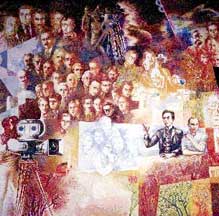
Autumn 1997 (5.3)

by Betty Blair

 Frankly
speaking, cinema is in trouble in Azerbaijan today. To create
a literary masterpiece requires only paper and pen in the hands
of a capable person of brilliant mind, tremendous willpower and
discipline. Cinema, on the other hand, is an immensely complex
art form demanding sophisticated equipment and production along
with a highly trained team of dedicated technicians and artists.
The bottom line is that movie making is exorbitantly expensive
and requires either the sponsorship of the national government
or the investment of private enterprise. During this transitional
period that Azerbaijan is experiencing since independence (1991),
filmmakers barely eke out a living from either source. Only four
films are slated for 1997 although Azerbaijani filmmakers have
the capability of producing at least 12 films annually.
Frankly
speaking, cinema is in trouble in Azerbaijan today. To create
a literary masterpiece requires only paper and pen in the hands
of a capable person of brilliant mind, tremendous willpower and
discipline. Cinema, on the other hand, is an immensely complex
art form demanding sophisticated equipment and production along
with a highly trained team of dedicated technicians and artists.
The bottom line is that movie making is exorbitantly expensive
and requires either the sponsorship of the national government
or the investment of private enterprise. During this transitional
period that Azerbaijan is experiencing since independence (1991),
filmmakers barely eke out a living from either source. Only four
films are slated for 1997 although Azerbaijani filmmakers have
the capability of producing at least 12 films annually.
When we began preparations for this issue, the gigantic building
which houses the national cinema studio, AzerFilm, had just been
shut down. The electric and heating bill had not been paid for
five years. A thousand people used to work there. Today, it lies
nearly vacant.
The question is "Can Azerbaijani
film be revived?" The rich historical heritage of film would
indicate that it can be, especially when coupled with the tremendous
creative and artistic human resources that are available in Azerbaijan.
That's why we have devoted this entire issue to the subject.
Direction and guidance for these
pages has come from Guest Editor, Rustam
Ibrahimbeyov, Azerbaijan's most prominent screenwriter, whose
work, "Burnt by the Sun" won the Cannes Festival
(1994) and the Oscar (Academy Award) for "Best Foreign Film"
(1995).

 Left:
Mural in Baku's main Cinema commemorating Azerbaijan's filmmakers
of the 20th century. Photo: Eileen Heraghty. Note: Mural no longer
exists since the Cinema has been remodeled in 1998.
Left:
Mural in Baku's main Cinema commemorating Azerbaijan's filmmakers
of the 20th century. Photo: Eileen Heraghty. Note: Mural no longer
exists since the Cinema has been remodeled in 1998.
Though Mr. Ibrahimbeyov is currently
involved with filmmaking in Los Angeles, Paris and Moscow as
well as elsewhere, he continues to be one of the major driving
forces for cinema, not only in Azerbaijan where he heads the
Cinematographers' Union, but in the former Soviet Union, where
he is the Acting Chair of what used to be the All-Cinematographers'
Union in Moscow.
It was his vision that identified
the broad scope of topics discussed here and which identified
the experts-the film directors, critics and journalists-who have
summarized the issues. Aydin Kazimzade, Deputy Editor of the
Azerbaijan Cinema Encyclo-pedia, also assisted tremendously with
the coordination of this issue.
Azerbaijan is looking for relationships
outside their small country. They'll looking for exchange of
ideas, for filmmakers to come explore their land and for investors
for their projects. They're looking for creative ways to revitalize
and reinvigorate the exciting world of cinema that they consider
essential in rebuilding the minds and hearts of their new nation.
We hope you'll catch the spirit of their vision in the pages
that follow.
Betty Blair, Editor
Cinema: An Age-Old
Tree
by Rustam Ibrahimbeyov
Azerbaijan's initial experiments
in cinema date back to some of the oldest motion pictures produced
in the world. Next year, 1998, will mark our centennial which
follows three years on the heels of the world centennial which
was celebrated in France in 1995.
Cinema is one of those plastic
arts. Even the most detailed re-creation of a story is a feeble
reflection of the complexities, the depth and nuance of everyday
life. It is even more complicated to speak about the vast variety
of films that have been created over the entire 20th century
and that make up the body of work what might be referred to as
the tree of Azerbaijani national cinema.
The collection of films that
have been produced in our country over this century, cinematically
speaking, comprise what could be visualized as an age-old tree.
Each new film extends a genre or branch of what, in truth, is
a vibrant living organism in the minds and hearts of our people.
It's only natural that our tree is a unique species. It's shape,
its size, its coloration, its texture and its ability to endure
and withstand hardship differs from trees nourished and originating
in other national soils and national souls. However, despite
how unique and singular our tree might be, simultaneously, we
are undeniably part of the great garden of world cinema.
Only recently, since Azerbaijan
has gained its independence (1991) has the world community begun
to turn its attention to the land that has nurtured this tree
and to the dramatic fate of the people living here. Azerbaijan
is still largely unknown to the world audience.
But cinema cannot be defined
as art alone. Nor is it mere technique, industry or business.
Cinema constitutes an integral image of the people and land on
which it was created over the duration of their historical development.
These days, opportunities are
beginning to emerge that enable Azerbaijan cinema to move beyond
the borders of our own country and to begin to impact the world
community. I, along with my colleagues in filmmaking, value this
gesture by "Azerbaijan International" magazine in facilitating
this interactive process as they dedicate this entire issue to
our needs and dreams.
Above: Azerbaijan's National Film Studio,
known as AzerFilm, virtually stands empty these days for lack
of funding.
We are convinced that Azerbaijan
has the potential of attracting business partnership interests
from the outside world. Our filmmaking professionals across a
broad spectrum of specialization are willing and capable of becoming
involved in international projects. Our city, particularly the
medieval inner city and the magnificent palaces of the oil barons
beckon foreign filmmakers to explore our photogenic qualities.
The broad spectrum of our landscape-from the rugged peaks of
the Caucasus with its quaint villages to the energy-producing
Caspian Sea provide a wide variety of cinematic settings within
close proximity of each other.
Add to this, the immense interest
for film within our country itself. Our numerous film theaters
throughout the country are potential clients for the distribution
of foreign features. Our spirit of internationalism and our curiosity
and tolerance for other languages also foster international relationships.
Nowadays, Azerbaijan's film
industry faces the same dilemmas of the other 14 republics of
the Soviet Union. Our transition to a market economy has seriously
crippled filmmaking efforts. Funds, once allocated from the central
government for the creation, production and distribution of films,
have been slashed. We're left in a dreadful state of affairs,
especially from a technical point of view.
For starters, not a single theater
in Baku is equipped with a modern stereo sound system. The list
could go on endlessly. However, even the most superficial analysis
of the state of Azerbaijani cinema today leads one to conclude
that the incredible problems are possible to solve, and that
the most critical factor is foreign investment.
In Russia, for example, new
modern film theaters, equipped to world standard, are opening.
Premiere screenings of films from around the world are being
shown (first, and foremost, one should note, from the United
States). Such theaters have already proven to be quite lucrative.
There is no doubt that investment in the film production in Azerbaijan
also has a promising future.
Home | About
Azeri | Learn
Azeri | Arabic
Script | Store | Contact
us
Articles from Azerbaijan
International
© Azerbaijan International. Copyright 2003. All rights reserved.
|
|